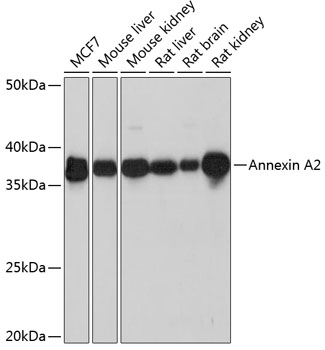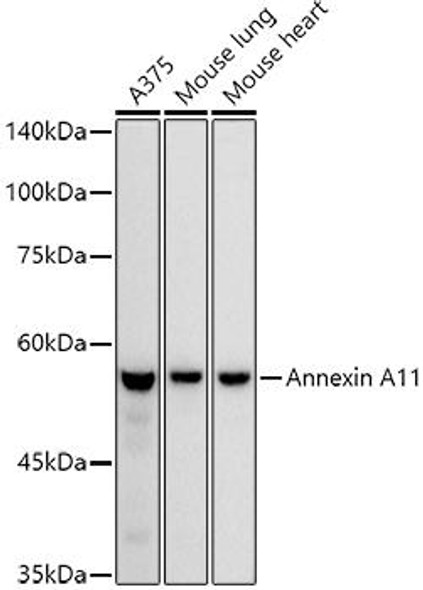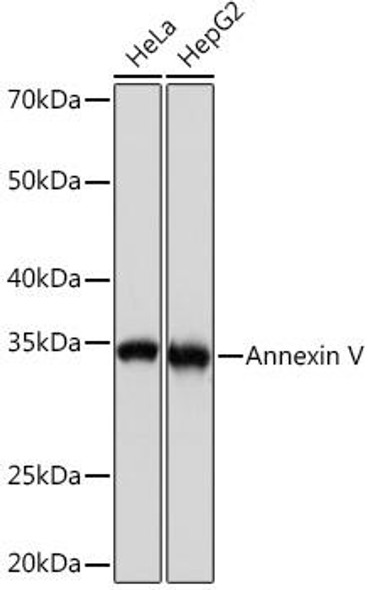Immunology Antibodies 3
Anti-Annexin A2 Antibody (CAB11235)
- SKU:
- CAB11235
- Product Type:
- Antibody
- Reactivity:
- Human
- Reactivity:
- Mouse
- Reactivity:
- Rat
- Host Species:
- Rabbit
- Isotype:
- IgG
- Antibody Type:
- Monoclonal Antibody
- Research Area:
- Immunology
Description
| Antibody Name: | Anti-Annexin A2 Antibody |
| Antibody SKU: | CAB11235 |
| Antibody Size: | 20uL, 50uL, 100uL |
| Application: | WB IHC |
| Reactivity: | Human, Mouse, Rat |
| Host Species: | Rabbit |
| Immunogen: | A synthesized peptide derived from human Annexin A2 |
| Application: | WB IHC |
| Recommended Dilution: | WB 1:500 - 1:2000 IHC 1:50 - 1:200 |
| Reactivity: | Human, Mouse, Rat |
| Positive Samples: | MCF7, Mouse liver, Mouse kidney, Rat liver, Rat brain, Rat kidney |
| Immunogen: | A synthesized peptide derived from human Annexin A2 |
| Purification Method: | Affinity purification |
| Storage Buffer: | Store at -20°C. Avoid freeze / thaw cycles. Buffer: PBS with 0.02% sodium azide, 0.05% BSA, 50% glycerol, pH7.3. |
| Isotype: | IgG |
| Sequence: | Email for sequence |
| Gene ID: | 302 |
| Uniprot: | P07355 |
| Cellular Location: | |
| Calculated MW: | 38kDa |
| Observed MW: | 39KDa |
| Synonyms: | ANX2, ANX2L4, CAL1H, HEL-S-270, LIP2, LPC2, LPC2D, P36, PAP-IV |
| Background: | This gene encodes a member of the annexin family. Members of this calcium-dependent phospholipid-binding protein family play a role in the regulation of cellular growth and in signal transduction pathways. This protein functions as an autocrine factor which heightens osteoclast formation and bone resorption. This gene has three pseudogenes located on chromosomes 4, 9 and 10, respectively. Multiple alternatively spliced transcript variants encoding different isoforms have been found for this gene. [provided by RefSeq, Jul 2008] |
| UniProt Protein Function: | ANXA2: a calcium-regulated membrane-binding protein whose affinity for calcium is greatly enhanced by anionic phospholipids. It binds two calcium ions with high affinity. Heterotetramer containing 2 light chains of S100A10 2 heavy chains of ANXA2. May cross-link plasma membrane phospholipids with actin and the cytoskeleton and be involved with exocytosis. Annexins are a family of structurally related proteins whose common property is calcium-dependent binding to phospholipids. There are at least ten different annexins in mammalian species. Annexins do not contain signal peptides, yet some annexins (A1, A2 and A5) appear to be secreted in a physiologically regulated fashion. |
| UniProt Protein Details: | Protein type:Motility/polarity/chemotaxis; Calcium-binding; Lipid-binding Chromosomal Location of Human Ortholog: 15q22.2 Cellular Component: extrinsic to plasma membrane; extracellular space; cell surface; protein complex; lysosomal membrane; late endosome membrane; early endosome; lipid particle; cell cortex; lipid raft; ruffle; extracellular matrix; membrane; perinuclear region of cytoplasm; plasma membrane; melanosome; basement membrane; midbody; nucleus; sarcolemma; vesicle; endosome Molecular Function:protein binding; phosphatidylinositol-4,5-bisphosphate binding; calcium-dependent phospholipid binding; phospholipase A2 inhibitor activity; cytoskeletal protein binding; calcium ion binding; calcium-dependent protein binding; Rab GTPase binding Biological Process: fibrinolysis; positive regulation of fibroblast proliferation; collagen fibril organization; negative regulation of catalytic activity; positive regulation of vesicle fusion; protein heterotetramerization; positive regulation of binding; positive regulation of protein amino acid phosphorylation; angiogenesis; lipid raft formation; body fluid secretion; membrane budding |
| NCBI Summary: | This gene encodes a member of the annexin family. Members of this calcium-dependent phospholipid-binding protein family play a role in the regulation of cellular growth and in signal transduction pathways. This protein functions as an autocrine factor which heightens osteoclast formation and bone resorption. This gene has three pseudogenes located on chromosomes 4, 9 and 10, respectively. Multiple alternatively spliced transcript variants encoding different isoforms have been found for this gene. [provided by RefSeq, Jul 2008] |
| UniProt Code: | P07355 |
| NCBI GenInfo Identifier: | 113950 |
| NCBI Gene ID: | 302 |
| NCBI Accession: | P07355.2 |
| UniProt Secondary Accession: | P07355,Q567R4, Q6N0B3, Q8TBV2, Q96DD5, Q9UDH8, |
| UniProt Related Accession: | P07355 |
| Molecular Weight: | 40,411 Da |
| NCBI Full Name: | Annexin A2 |
| NCBI Synonym Full Names: | annexin A2 |
| NCBI Official Symbol: | ANXA2 |
| NCBI Official Synonym Symbols: | P36; ANX2; LIP2; LPC2; CAL1H; LPC2D; ANX2L4; PAP-IV; HEL-S-270 |
| NCBI Protein Information: | annexin A2; annexin-2; protein I; annexin II; lipocortin II; chromobindin 8; chromobindin-8; calpactin I heavy chain; calpactin-1 heavy chain; calpactin I heavy polypeptide; placental anticoagulant protein IV; epididymis secretory protein Li 270 |
| UniProt Protein Name: | Annexin A2 |
| UniProt Synonym Protein Names: | Annexin II; Annexin-2; Calpactin I heavy chain; Calpactin-1 heavy chain; Chromobindin-8; Lipocortin II; Placental anticoagulant protein IV; PAP-IV; Protein I; p36 |
| Protein Family: | Annexin |
| UniProt Gene Name: | ANXA2 |
| UniProt Entry Name: | ANXA2_HUMAN |







